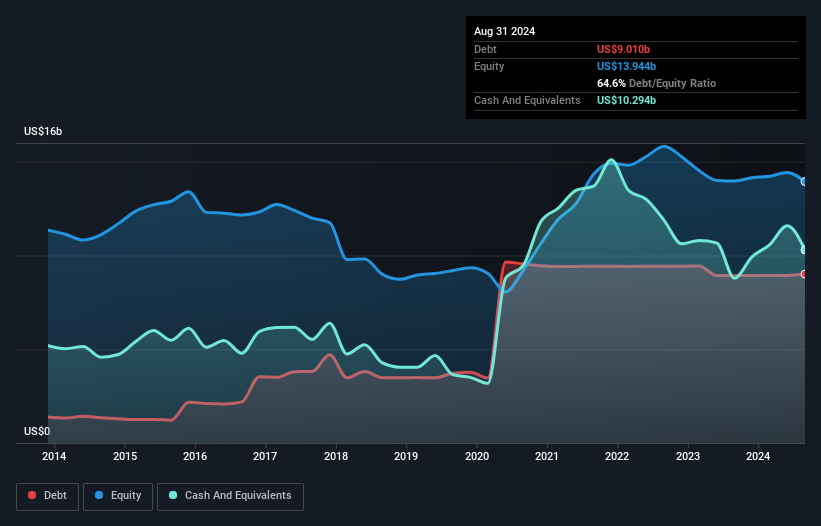Legendary fund manager Li Lu (who Charlie Munger backed) once said, 'The biggest investment risk is not the volatility of prices, but whether you will suffer a permanent loss of capital.' So it might be obvious that you need to consider debt, when you think about how risky any given stock is, because too much debt can sink a company. As with many other companies NIKE, Inc. (NYSE:NKE) makes use of debt. But is this debt a concern to shareholders?
What Risk Does Debt Bring?
Debt is a tool to help businesses grow, but if a business is incapable of paying off its lenders, then it exists at their mercy. If things get really bad, the lenders can take control of the business. However, a more common (but still painful) scenario is that it has to raise new equity capital at a low price, thus permanently diluting shareholders. Of course, plenty of companies use debt to fund growth, without any negative consequences. When we think about a company's use of debt, we first look at cash and debt together.
See our latest analysis for NIKE
What Is NIKE's Net Debt?
As you can see below, NIKE had US$9.01b of debt, at August 2024, which is about the same as the year before. You can click the chart for greater detail. But on the other hand it also has US$10.3b in cash, leading to a US$1.28b net cash position.

A Look At NIKE's Liabilities
According to the last reported balance sheet, NIKE had liabilities of US$10.6b due within 12 months, and liabilities of US$13.3b due beyond 12 months. Offsetting these obligations, it had cash of US$10.3b as well as receivables valued at US$4.76b due within 12 months. So it has liabilities totalling US$8.87b more than its cash and near-term receivables, combined.
Given NIKE has a humongous market capitalization of US$114.9b, it's hard to believe these liabilities pose much threat. Having said that, it's clear that we should continue to monitor its balance sheet, lest it change for the worse. While it does have liabilities worth noting, NIKE also has more cash than debt, so we're pretty confident it can manage its debt safely.
The good news is that NIKE has increased its EBIT by 9.2% over twelve months, which should ease any concerns about debt repayment. When analysing debt levels, the balance sheet is the obvious place to start. But ultimately the future profitability of the business will decide if NIKE can strengthen its balance sheet over time. So if you want to see what the professionals think, you might find this free report on analyst profit forecasts to be interesting.
Finally, a company can only pay off debt with cold hard cash, not accounting profits. NIKE may have net cash on the balance sheet, but it is still interesting to look at how well the business converts its earnings before interest and tax (EBIT) to free cash flow, because that will influence both its need for, and its capacity to manage debt. Over the last three years, NIKE recorded free cash flow worth a fulsome 83% of its EBIT, which is stronger than we'd usually expect. That positions it well to pay down debt if desirable to do so.
Summing Up
We could understand if investors are concerned about NIKE's liabilities, but we can be reassured by the fact it has has net cash of US$1.28b. And it impressed us with free cash flow of US$7.2b, being 83% of its EBIT. So is NIKE's debt a risk? It doesn't seem so to us. Over time, share prices tend to follow earnings per share, so if you're interested in NIKE, you may well want to click here to check an interactive graph of its earnings per share history.
If, after all that, you're more interested in a fast growing company with a rock-solid balance sheet, then check out our list of net cash growth stocks without delay.
Valuation is complex, but we're here to simplify it.
Discover if NIKE might be undervalued or overvalued with our detailed analysis, featuring fair value estimates, potential risks, dividends, insider trades, and its financial condition.
Access Free AnalysisHave feedback on this article? Concerned about the content? Get in touch with us directly. Alternatively, email editorial-team (at) simplywallst.com.
This article by Simply Wall St is general in nature. We provide commentary based on historical data and analyst forecasts only using an unbiased methodology and our articles are not intended to be financial advice. It does not constitute a recommendation to buy or sell any stock, and does not take account of your objectives, or your financial situation. We aim to bring you long-term focused analysis driven by fundamental data. Note that our analysis may not factor in the latest price-sensitive company announcements or qualitative material. Simply Wall St has no position in any stocks mentioned.
About NYSE:NKE
NIKE
Designs, develops, markets, and sells athletic and casual footwear, apparel, equipment, accessories, and services for men, women, and kids in North America, Europe, the Middle East, Africa, Greater China, the Asia Pacific, and Latin America.
Flawless balance sheet established dividend payer.
Similar Companies
Market Insights
Community Narratives





